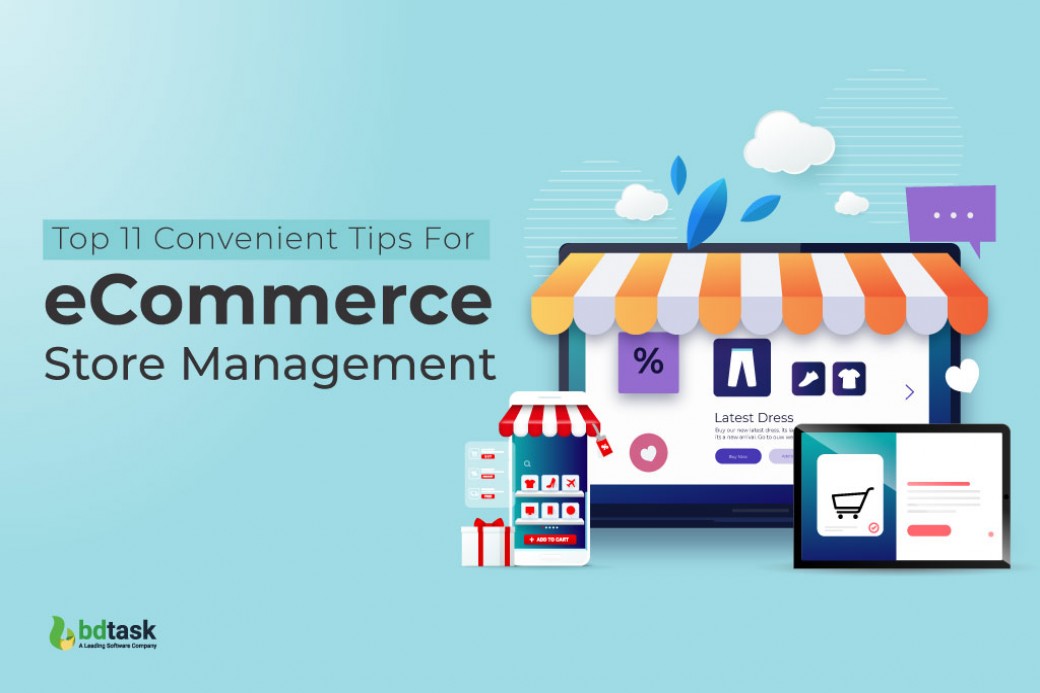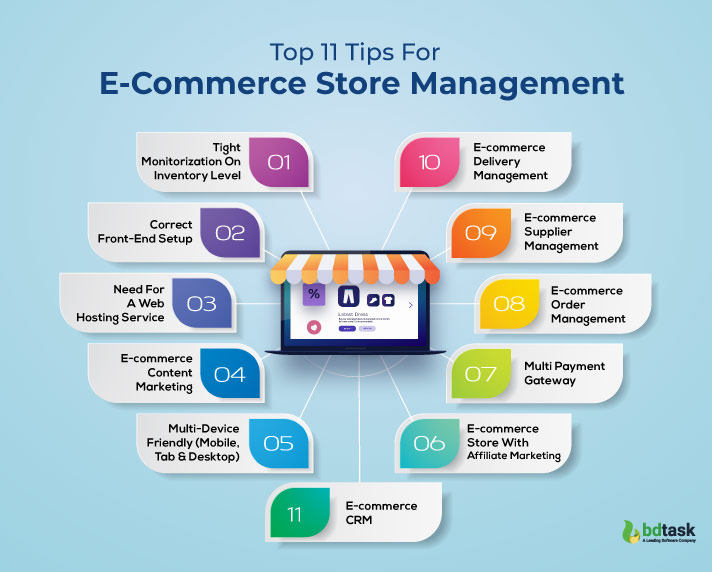Top 11 Convenient Tips For eCommerce Store Management

E-commerce stores are now the most controversial and hot topic to talk about. Currently, it’s the most hyped-up business; some secondary statistics have already proven that, mentioned a forecasted growth of the e-commerce business of 2024 by 6.913 billion. And achieving so much within a short period of time could only be achieved because of proper maintenance of e-commerce store management.
The e-commerce store business is not only becoming popular but also many potential entrepreneurs have invested and entered this market; as a result, competition has become fierce.
Managing an “E-commerce business” isn’t that hard, but you still have to maintain customer engagement and better eCommerce store management. Hence, this blog is dedicated to the e-commerce entrepreneur and tips for e-commerce store management.
Meaning Of Ecommerce Store Management
E-commerce store management is defined as the maintenance and monitoring of all the activities of an e-commerce store so that it becomes easier to convert visitors into customers.
There are an ample number of eCommerce shopping cart software available in the market, chosen based on the needs. This kind of software assists an eCommerce website in running the whole operation smoothly.
Some might think that doing eCommerce business is that easy, but unfortunately, managing an eCommerce website is quite hard, for instance, monitoring the eCommerce website, smooth internet service, employing a website manager and also a vendor, etc.
Moreover, handle the website functionality and improve the UX/UI, schedule for updating the website, monitor the website performance, update both the image and word content, monitor the website security, and structurize the off-page SEO.
How Can You Manage Your E-Commerce Store Management
E-commerce store management is one “broad term” which holds multiple aspects of “process, tools, employee resources needed to handle, and analytics needed to manage an “e-commerce store management”.
E-commerce is an online open marketplace where anyone can visit and purchase their desire, spending zero wastage of time. You can say an online marketplace; customers don’t expect any hassle or delay; as a result, proper e-commerce store management is needed, which includes branding, UX/UI design, coding, content/ copywriting, marketing, etc.
E-commerce store handlers need to understand the “audience behavior”, the bounce rate of the eCommerce website, and especially the shopping cart saved by customers. For analysis, the e-commerce management team doesn’t have to do much; it just has to observe, find & correct the bug, and understand the customer behavior. The only thing that matters; while handling your e-commerce website; is “how your website is running” and “how successfully you can generate a conversion rate”.
Why Need For eCommerce Website Management?
An eCommerce website should always be customer-centric, but whatever favors the customer's usability. Hence, it's wise to hire an expert group of employees who will keep analyzing and running the whole system 24*7.
Here are some potential requirements that need to be fulfilled to boost your eCommerce store website.
- Update Your Product List Day To Day
- Instant Correction Of Any Bug Or Glitch
- 24*7 Customer Support (Chatbot)
- Always Highlight The Trendy Products On The Top
- Polishing The E-Commerce Brand Image
- Maintain The Speed Of The Website
- Social Media Promotion
- Routine Check (Website Analytics)
- Rank The Ecommerce Site In User Search Intent
- Update The Intellectual Property Rights For Your E-Commerce Site (Copyright, Patent, And Trademark)
Top 11 Tips For eCommerce Store Management
The list below holds not only “the top 11 tips for eCommerce store management” but also 11 proven ways to handle and boost up your e-commerce website.

1. Tight Monitorization On Inventory Level
An E-commerce website is an open online marketplace. A place where a customer gets the full freedom to choose any product. Therefore to provide the best, fast & smooth all the products or items needs to be in the warehouse.
Whenever any purchase happens on the eCommerce website, using the Artificial intelligence tool, that individual item needs to notify the Inventory management team so that they can start the shipping process in real time.
Moreover, the inventory management team is also responsible for deciding the “delivery time which is prefixed by the company policy”.
The backend eCommerce website should be sync-able with inventory management; as a result, whenever any individual product gets purchased, it will show how many are left in the inventory panel, and if that individual product gets stocked out, it will show “stock out” both in front-end of the website, and also in the inventory record.
And to ease up this kind of complicated process, an eCommerce entrepreneur can adopt an effective inventory management system, which heavily assists in inventories, assorting ordering, pre-ordering, shipping, recording, overstocking, and handling the whole inventory process.
2. Correct Front-End Setup
Another eye-opening tip for ecommerce store management is how you can perfectly decorate the front end of your ecommerce website because this is the part which a customer or audience will view and use.
a) Front-End Infrastructure
An ecommerce website’s front end should always be infrastructured as “simple”,” clean”, and “user-friendly” and constructed with plain HTML along PHP, My SQL, JavaScript, and ReactJS. Applying a straightforward front-end design impacts the conversion rate. The main purpose is to serve a painless, less time-consuming, hassle-free shopping experience.
b) CTA Button Placement
Moreover, it's also a matter of concern "which front size will be the best appropriate for the website; try to use an "easy to read front" and try to maintain a one-size image policy, as image size puts a huge impact on" page load".
Another thing that I will be putting light on is to "correct placement of the call to action (CTA button)". Before putting any CTA button, it's wise to understand, observe and monitor the customer's psychology & behavior first.
This image was collected from a secondary source called “Trueconversion”, where it’s clearly defined; if any customer finds a “1-second delay in page loading, it converts into a 7% loss in conversion rate. The more you can avoid clutter, the less the chance of confusion among the audience.
c) Search Engine Bar
Furthermore, the front end of the eCommerce website should have a Mandatory Search Engine Bar where an audience can write and browse for their desired product.
After an audience lands on the "home page", they obviously would want to search for a specific desired product instead of roaming around and relying on navigation. And to measure "how much your search engine bar is being used, you can use a plug-in to keep track of the user's search activity and their search intent.
d) Product Image And Video Demonstration
Besides, adding product images + descriptions and small demonstration product videos is also one of the unavoidable tasks of managing an e-commerce store management.
As an e-commerce entrepreneur, you've to remember that "online marketplace won't give the same experience that you gain from the physical marketplace, no-option for trial. Your audience will only rely on the fictional product image with a description (the only chance to highlight your product UPS).
Tip 1# Try to provide a clear crystal image with a multiple-angle view.
Tip 2# Try to provide a short, to-the-point (bullet-wise) product description, especially highlighting the product's key attributes.
And in the case of adding short demo videos of the product will help to gain mental satisfaction among the audience. Videos" will try to provide a realistic feeling, "how products look from different angles", and easy to understand the product value and reliability.
3. Need For A Web Hosting Service
Another effective and mandatory tool to manage an ecommerce store is the “need of web hosting service”. Web hosting provides a rental service to the e-commerce website entrepreneur so that they can save and record important files, ease up payment processing services, security initiatives,ecommerce shopping cart software and many more.
And before you choose a web hosting service holder, you’ve to understand how much will be your “sales volume per month”, “traffic”, and “site size”, the web hosting performance and the categories of security they’re going to provide your e-commerce store.
Disclaimer 1 # Ecommerce Speed Is Very Important
If your web hosting service provider is slow, your ecommerce store SPEED will get slow and, as a result, will turn into a bad user experience and loss of potential revenue.
Disclaimer 2 # Choose The Right Hosting Type
To host an ecommerce website, you will either need a shared VPS or cloud solution; whichever you choose needs to be based on the size of your website and the traffic on it per month.
Disclaimer 3 # Standard cPanel Vs Custom cPanel
Standard cPanel is easy to use, especially for newbies, and custom cPanel provides a very well-organized space to work on.
Disclaimer 4 # Encryption
To run an ecommerce store, ensuring security is always mandatory. Hence many hosting plans will offer extraordinary security features such as; Firewalls, SSL certificates, DDoS protection, Spam filters, Domain name privacy and Virus protection.
Disclaimer 5 # Maintains Backup For Everything
You don't know when things might go wrong, or after updating the website, no details get saved up; hence it's better to keep a backup of every detail. Try to maintain regularity in backing up your data so that it doesn't result in a massacre later, and make sure you store the data on some separate server so that, if needed, it can easily be accessed or restored.
4. Ecommerce Content Marketing
Whatever business you get engaged in, you cannot survive without doing content marketing. Because "Content Is Always The King Of Your Business", people enjoy both verbal and visual content.
You Might Be Thinking!!
"How Does Content Marketing Help Ecommerce Stores?"
But yes!! It does help! Check out this wonderful statistic collected from "semrush."
From the statistics, it can be assured that video content effectively promotes your ecommerce product. Still, at the same time, a "Blog Post" for your ecommerce store will help your audience establish a nurture-ness in their mind.
Ecommerce Content Marketing basically explores, breakdown and tries to provide an ideal solution; "pain-point of the customer", "talks about the buyer's journey", "the possible scope of regenerating your customer", "how to start an ecommerce business from scratch" and many more.
Moreover, each and every piece of content should be SEO- friendly so that it's easy to maintain a regularity on content publishing, helps to build a trustworthy relationship with your customer, gain organic traffic, organically establish the brand identity, and enhance the chance of customer engagement, etc.
5. Multi-Device Friendly (Mobile, Tab, And Desktop)
Keeping your website multi-device friendly has become mandatory because some secondary source has proven that almost 59% are mobile users, and it’s gradually increasing at a no-slow rate.
Since “mobile” is now the most usable device by every user, as a result, they think mobile is more handy, easy to access, and increases the chance of surfing and doing digital window shopping. As a result, 85% of adults think the mobile version is much better than the desktop version, but unfortunately, it’s not; in fact, sometimes the audience gets irritated, especially while using (pinch-and-zoom or fat-finger errors).
Hence, it’s essential for every ecommerce store management needs to optimize their ecommerce store as “a mobile responsible feature, which will bring seamless usability across various screens and sizes.
Moreover, in 2019, Google started to consider the mobile version of the website a valuable ranking factor.
Optimizing the mobile version of the website has a big effect on SEO, gathering more organic traffic and capturing more visitors. Besides, “how much it takes to load the mobile version of a website”, which puts a high impact on user experience and the bounce rate.
KEY POINTS TO HIGHLIGHT:
- Responsive Mobile Version Website
- E-Commerce Store Load Speed
- Optimize Mobile Version of Website And Improve Search Speed
- Simple The Checkout Process
- Try To Use Large CTA Buttons
6. Integrate Your Ecommerce Store With Affiliate Marketing
There is a beautiful relationship between the ecommerce store and affiliate marketing. In short, an affiliate marketer is getting engaged as a business partner; an affiliate marketer promotes their product in an ecommerce store, and as a result, it gets easier to gather quicker promotion for an “ecommerce store”.
Affiliate marketing is much more effective than paid advertising, especially for “new ecommerce start-up stores” because as a “new entrant”, it gets tough to gather potential leads with minimal cost. Affiliate marketers rent an “Ecommerce marketplace space” to showcase their products and get the chance to earn extra bucks.
One of the biggest advantages of doing affiliate marketing is that it allows earning a customer referral and commission per sale. The ecommerce store owner will provide the affiliate marketer with a unique link; the affiliate marketer will use that link to promote their product in their store. And per click by a customer, a purchase will happen, the ecommerce store owner will get sales, and the affiliate marketer will get the commission.
Affiliate marketers consider this whole process as a top customer acquisition method because this process is totally based on low investment and higher ROI.
Key Benefit Of Doing Affiliate Marketing:
- High ROI
- Enhance Social Exposure
- Increase In Organic Traffic Of E-Commerce Store
- Opportunity To Gain Affiliate Commission
- Cost- Effective Way Promotion
7. Multi Payment Gateway
Having a smooth but, at the same time, secure payment gateway is one of the most important parts of every ecommerce store. Offering a multi-payment gateway is one of the major requirements sought by the customer.
Whenever any customer goes for the "check-out" option, simultaneously he/she has to fill up all the necessary contact addresses, phone numbers, bank details, billing information etc.
Disclaimer# Try to keep the whole payment process shorter, "1-click purchase process", because the more steps you add, the more chance you're giving your audience to abandon the cart.
Key Point To Consider Before Choosing Payment Gateway
- Highly Secured
- Strong Website Integration
- Clear Fess And Service Policy
- 24*7 Customer Support
- Responsible chatbot
- Multi-Currency Facilities
List Of Popular Payment Gateway
- PayPal
- Square
- Stripe
- Apple Pay
- Amazon Pay
- Authorize.net
- Adyen
- Sezzle
- Checkout.com
- WorldPay Core
8. E-commerce Order Management
E-commerce order management is one of the major parts of ecommerce store management. The order management process is completely a back-end process, and it starts right after "order confirmation" by a customer until the customer reaches the doorstep.
Total ecommerce order management is a complex process, but if you can handle it properly, it won't be that complicated. Managing multiple orders from multiple distribution channels and third-party logistics is quite a long and complex process, hence using an effective e-commerce shopping cart software with a manageable "Order management module".
Multiple Task Happens In This Ecommerce Order Management Module
- Track Order
- Order ID
- Communication Maintenance
- Payment Confirmation
- Notify The Inventory Management Department About The Inventory Level
- Order Processing
- Third-Party Logistics Maintenance
- Order fulfillment
Workflow Of E-Commerce Order Management
Step 1: Online Order Placed
Step 2: Ecommerce Store Accept The Purchase Order Details
Step 3: Customer Will Receive A Notification About The Order Confirmation
Step 5: “Sales Order” Is Being Notified To The Inventory Level
Step 6: Order Details To The Ecommerce Store,
Step 7: Product Are Picked, Packaged, And Shipped By The Warehouse Team
Step 8: “Order Has Been Dispatched, Confirmation Send To Customer
Step 9: Customer Receive The Purchase
Step 10: Ready For Customer Review
9. E Commerce Supplier Management
Another essential tip for ecommerce store management is effectively managing your ecommerce supplier because it holds many crucial factors for running an e-commerce website store.
With the technology getting advanced, it’s obvious that an ecommerce shopper expects faster and smoother delivery. To make that happen, some well full-proof supply chain team is absolutely necessary.
Integrating an ecommerce supply chain management aids the flow of the whole ecommerce operation, from getting an order from a customer to the order reaching the final customer.
An Ecommerce Store Management Supply Management Includes The Following:
- List of Suppliers (name, address, details,contact information, ID)
- List of Manufacturer (name, address, details,contact information, ID)
- List of Vendors
- List of Warehouse (state/city wise, supplier wise, product wise)
- List of Third-party Logistics
- Inventory Tracking
Moreover, using e-commerce supply chain management gives an automated touch to the e-commerce entrepreneurs; as a result, it becomes easier to oversee the product demand report, the inflow and outflow of inventory from the warehouse, the consistency of their supply, record the order slip and distribution schedules etc.
Crucial Benefit Adopting E Commerce Supply Chain Management
- Effectively handle multi-channel selling
- Minimize the operational cost
- Reduce lead time
- Real Time Update of inventory availability
- Instantaneous response to any kind of fluctuation or delays
- Preciously forecast the sales and other crucial data
10. E-commerce Delivery Management
While shopping on an ecommerce website, the first thing that comes to mind is "will get the desired product at a low price with faster delivery".
Hence to tighten your ecommerce delivery management system, one of the pro tips for ecommerce store management is to plan a strategy in such a way that it can ensure customers' desire, need, want and demand.
Ecommerce business has now become so competitive that every e-commerce entrepreneur offers a fast, troubleless delivery system to their customer. E-commerce delivery management is directly connected with order management, inventory management and customer relationship management.
As an ecommerce entrepreneur, every day you have to deal with hundred\thousand of orders received from different geographical locations, different customers, different products etc.
And honestly, it gets tough to handle if you EVER IMAGINE HAD TO HANDLED IT MANUALLY. Hence, a streamlined delivery management system is mandatory to handle multiple orders simultaneously.
As Effective E-Commerce Delivery Management System Includes the following:
- Delivery Schedule
- Delivery Man Personal Details
- Separate Schedule List Of Delivery Man
- Delivery Zone
- Assigned Delivery Slot
- Active/ Inactive Status
A strong ecommerce delivery management system is absolutely necessary because an ecommerce entrepreneur must have the ability to handle pressure and, at the same time, complete all the orders delivered at a dedicated time.
Moreover, these features majorly assist ecommerce stores in managing the orders they receive from ecommerce websites.
Not only does the ecommerce delivery system provide streamlining deliveries and ensures that all orders get dispatched properly and delivered on time. And ensuring "orders are delivered on time" is one of the essential priorities of every ecommerce store management.
11. E-commerce Customer Relationship Management
Believe it or not, But!!
“Customers” are the core essence of e-commerce websites.
If you’ve customers, you’ve business!! The total ecommerce business depends on the customer.
Hence maintaining the satisfaction level is also a major tip for ecommerce store management.
Ecommerce customer relationship management systems mainly analyze customer behavior traits, the shopping cart, search intent behavior, sales, product demand etc.
Hence, integration of an efficient customer relationship management system helps to collect some essential metrics/ KPIs such as conversion rates, customer click-through rate, which product customer is searching for more etc., which later on can help to predict the sales analytics, help you personalize your ecommerce store UX/UI, update the product list etc.
Why Maintaining CRM Important For E-commerce?
Maintaining customer relationship management aids in understanding the type of customer purchasing behavior, tracking their capabilities, product choice, search patterns, purchase habits etc.
Other effective tips for the ecommerce store management team are to improve not only the ecommerce UX/UI but also the website performance through using observation tools, constructing strategies, and applying marketing tactics.
- Better TRACK of supply and demand PRODUCT
- Maintain smooth navigation of the website
- Ability to create a better promotional marketing strategy
- Brush up the customer satisfaction level
- The secure, easy and simple check-out process
Bonus Tips For Ecommerce Store Management Entrepreneur
From the above 11 list of convenient tips for ecommerce store management, I think you’ve already got some disruptive ideas about “how you can tactfully manage and improve your ecommerce store.
But I Haven't Revealed The Secret Ingredient !!
“Improve Customer Satisfaction”
“Technologically Automation”
“Cost & Time Saving”
“Higher ROI”
“Website Integrated”
All can come into one software
Isshue- Ecommerce Shopping Cart Software
Manage Your E-Commerce Store Management- Final Words
For sure, running an ecommerce store is a very challenging task but also, at the same time, the easiest way to get quicker popularity, ROI, and easy reach to your differentiated/undifferentiated target audience. To be a successful ecommerce entrepreneur, you must apply for different trips for ecommerce store management.
But Still!! Not All “Easy schemes” Aren't Bringing Success Soon!!.It needs hard work!!
You’ve to apply different business strategies and marketing policies and very keenly observe the customer approach to your ecommerce store usability, their search choice of product, etc. And depending on that, you can reshape your ecommerce business, provide one step ahead customer satisfaction, and make better revenue in the coming days.










